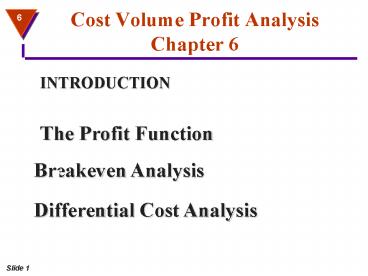Cost Volume Profit Analysis Chapter 6 - PowerPoint PPT Presentation
1 / 27
Title:
Cost Volume Profit Analysis Chapter 6
Description:
Using CVP to Analyze Different Cost Structures Using CVP to Analyze Different Cost Structures Using CVP to Analyze Different Cost Structures Margin of Safety Excess ... – PowerPoint PPT presentation
Number of Views:115
Avg rating:3.0/5.0
Title: Cost Volume Profit Analysis Chapter 6
1
Cost Volume Profit AnalysisChapter 6
INTRODUCTION The Profit Function
2
The Profit Equation
Operating Profit
Total Revenue
Total Costs
Operating profit equals total revenue less total
costs.
3
The Profit Equation
Operating Profit
Total Revenue
Total Costs
TR TC
4
The Profit Equation
Total Revenue
Average Selling Price Per Unit
Units of Output
TR P X
5
The Profit Equation
Total Costs
Variable Costs Per Unit
Units of Output
Fixed Costs
TC (V X) F
6
The Profit Equation
Now, well expand our original equation for
profits!
(P X) - (V X) F
7
The Profit Equation
Now, well expand our original equation for
profits!
(P X) - (V X) F
(P V)X F
8
Example
- Here is the information from the Hap Bikes
9
Example
(P V)X F
10
Finding Target Volumes
- The formula to find a volume expressed in units
for a target profit is . . .
Target Volume (units)
Fixed costs Target profit Contribution margin
per unit
How many bikes must Hap sell to earn an annual
profit of 100,000?
11
Finding Target Volumes
Target Volume (units)
Fixed costs Target profit Contribution margin
per unit
12
Proof
- If Hap sells 900 bikes, its operating profit
would be . . .
(P V)X F
13
Finding the Break-Even Point
- The Break-Even Point is the volume level where
profits equal zero. - To find the break-even point in units, we use the
target volume in units equation and set the
profit to zero. - To find the break-even point in sales dollars, we
use the target volume in sales dollars equation
and set the profit to zero.
14
Break-Even in Units
- Lets use the Hap Bikes information again.
Contribution margin ratio
15
Break-Even in Units
Break-Even Volume (units)
Fixed costs Target profit Contribution margin
per unit
16
Break-Even in Sales Dollars
Break-Even Volume (sales )
Fixed costs Target profit Contribution
margin ratio
80,000 0 .40
17
Target Volume in Sales Dollars
- We can calculate the target volume in sales
dollars using the contribution margin ratio.
Contribution margin per unit Sales price
per unit
18
Target Volume in Sales Dollars
- The equation for finding the target volume in
sales dollars is . . .
Target Volume (sales )
Fixed costs Target profit Contribution
margin ratio
19
Graphic Presentation
- Consider the following information for Hap Bikes
20
Graphic Presentation
Dollars
Volume per period (X)
21
Graphic Presentation
Dollars
Break-even point
Volume per period (X)
22
Using CVP to Analyze Different Cost Structures
- Cost structure - The proportion of fixed and
variable to total costs of an organization. - Operating leverage - The extent to which an
organizations costs structure is made up of
fixed costs.
Lets look at an example of different
costs structures for different companies.
23
Using CVP to Analyze Different Cost Structures
24
Using CVP to Analyze Different Cost Structures
Lets see what happens when both
companies experience a 10 increase in sales.
25
Using CVP to Analyze Different Cost Structures
26
Margin of Safety
- Excess of projected (or actual) sales over the
break-even volume. - The amount by which sales can fall before the
company is in the loss area of the break-even
graph.
Sales Break-even volume sales volume
Margin of Safety
27
Margin of Safety
- Hap is currently selling 500 bikes, and we
calculated the break-even to be 400 units
(80,000 fixed costs 200 contribution margin).































